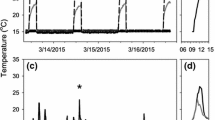Abstract
Exposure of blue mussels (Mytilus edulis L.) to oil-polluted sea water for 7 d in the laboratory did not affect their body fluid concentrations of inorganic ions and free amino acids. Mussels exposed to-4°C for 12 h did not freeze, whereas freezing occurred invariably in mussels exposed to-7°C or lower temperatures for the same period. Following freezing at-10°C, oil polluted mussels resumed normal activity considerably more slowly than unpolluted ones, but oil-polluted as well as unpolluted mussels showed normal activity 3 h after thawing. Freezing at-15°C was invariably lethal to individuals of both groups. One possible explanation of the delayed recovery of oil-polluted mussels frozen at-10°C may be that oil components had become concentrated to toxic levels as the amount of solvent water diminished during freezing.
Similar content being viewed by others
Literature Cited
Brisby, K.: Oil slicks effects on Ricon Island. Am. Pet. Inst. Spring Meeting, Proc. L. A. California, pp 147–150, 1969
Dunning, A. and C. W. Major: The effect of cold seawater extracts of oil fractions upon the blue mussel, Mytilus edulis. In: Pollution and physiology of marine organisms, pp 349–366. Ed. by F. J. Vernberg and W. B. Vernberg. New York: Academic Press 1974
Fossato, V. U., and W. J. Canzonier: Hydrocarbon uptake and loss by the mussel Mytilus edulis. Mar. Biol. 36, 243–250 (1976)
Geyer, R. and E. J. Bowie: The microdetermination of tissue calcium by flame photometry. Analyt. Biochem. 2, 360–369 (1961)
Kanwisher, J. W.: Freezing of intertidal animals. Biol. Bull. mar. biol. Lab., Woods Hole 109, 56–63 (1955)
Kanwisher, J. W.: Histology and metabolism of frozen intertidal animals. Biol. Bull. mar. biol. Lab., Woods Hole 116, 258–264 (1959)
Lange, R.: The osmotic fnction of amino acids and taurine in the mussel Mytilus edulis. Comp. Biochem. Physiol. 10, 173–179 (1963)
Little, J. R.: Determination of water and electrolytes in tissue slices. Analyt. Biochem. 7, 87–95 (1964)
Lutz, P. T.: Extracellular spaces and composition of various tissues of perch. Comp. Biochem. Physiol. 41A, 77–88 (1972)
Mackin, J. G. and S. H. Hopkins: Studies on oyster in relation to the oil industry. Publ. Inst. mar. Sci. Univ. Tex. 7, 1–131 (1962)
Meryman, H. T.: Osmotic stress as a mechanism of freezing injury. Cryobiology 8, 489–500 (1971)
Moore, S. and W. H. Stein: Photometric ninhydrin reagent for use in the chromatography of amino acids. J. biol. Chem. 176, 367–388 (1948)
Moore, S. and W. H. Stein: A modified ninhydrin reagent for the photometric determination of amino acids and related compounds. J. biol. Chem. 211, 907–913 (1954)
Mori, K.: Direct microcomplexiometric analysis of calcium in biological materials. Arch. Biochem. Biophys. 83, 552–562 (1959)
Murphy, D. J. and S. K. Pierce, Jr.: The physioloical basis for changes in freezing tolerance of intertidal molluscs. I. Response to subfreezing temperatures and the influence of salinity and temperature acclimation. J. exp. Zool. 193, 313–322 (1975)
Murphy, D. J.: A calcium-dependent mechanism responsible for increasing the freezing tolerance of the bivalve mollusc Modiolus demissus. J. exp. Biol. 69, 13–21 (1977)
Potts, T. W.: The inorganic composition of the blood of Mytilus edulis and Anodonta cygnea. J exp. Biol. 31, 376–385 (1954)
Schoffeniels, E. and R. Gilles: Ionoregulation and osmoregulation in Mollusca. In: Chemical zoology, pp 393–420. Vol. 7. Ed. by M. Florkin and B. T. Scheer. New York: Academic Press 1972
Simpson, A. C.: Oil, emulsifier and commersial shellfish. In: The biological effects of oil pollution on littoral communities, pp 1–91. Ed by J. D. Carthy and D. R. Arthur. Field Studies Council 1968
Swedmark, M. B., E. Emanuelsen and Å. Granmo: Biological effects of surface active agents on marine animals. Mar. Biol. 9, 183–201 (1971)
Whittam, R.: A conventional micromethod for the estimation of tissue chloride. J. Physiol. 120, 65 (1955)
Williams, R. J.: Freezing tolerance in Mytilus edulis. Comp. Biochem. Physiol. 35, 145–161 (1970)
Author information
Authors and Affiliations
Additional information
Communicated by O. Kinne, Hamburg
Rights and permissions
About this article
Cite this article
Aarset, A.V., Zachariassen, K.E. Effects of oil pollution on the freezing tolerance and solute concentration of the blue mussel Mytilus edulis . Mar. Biol. 72, 45–51 (1982). https://doi.org/10.1007/BF00393946
Accepted:
Issue Date:
DOI: https://doi.org/10.1007/BF00393946




